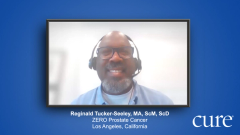
Screening and Diagnosis of Prostate Cancer
Reginald Tucker-Seeley, MA, ScM, ScD, gives an overview of the screening and diagnosis process of prostate cancer.
Episodes in this series

This is a synopsis of an Educated Patient Sound Bites series featuring Alicia Morgans, MD, MPH, of Dana-Farber Cancer Institute; Rashid K. Sayyid, MD, MSc, of the University of Toronto; and Reginald Tucker-Seeley, MA, ScM, ScD, of ZERO Prostate Cancer.
Dr Reginald Tucker-Seeley, MA, ScM, ScD, Vice President of Health Equity at ZERO Prostate Cancer, addresses prostate cancer screening guidelines that can be confusing across age groups. While screening starts at age 50, he notes men at high risk, including African Americans or those with family history, should talk to their primary care physician about screening in their 40s, per ZERO recommendations.
In terms of screening methods, Dr Tucker-Seeley outlines 3 tools endorsed by clinical guidelines – the prostate-specific antigen (PSA) blood test, digital rectal exam, and magnetic resonance imaging (MRI). He acknowledges men may be uncomfortable with the brief digital rectal exam but believes it’s worth enduring to save lives.
In summary, Dr Reginald Tucker-Seeley offers clarification on prostate cancer screening, recommending high-risk men to start discussions in their 40s given family history or genetic risk. He outlines the screening modalities per guidelines – PSA, digital rectal exam, and MRI – arguing the brief discomfort of the exam is justified to enable early detection and save lives.
*Video synopsis is AI-generated and reviewed by CURE editorial staff.







